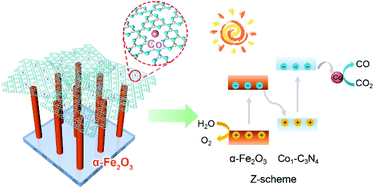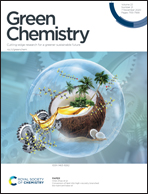Integrating Z-scheme heterojunction of Co1-C3N4@α-Fe2O3 for efficient visible-light-driven photocatalytic CO2 reduction†
Abstract
Photocatalytic CO2 reduction coupled with water oxidation provides a fascinating approach to mitigating the issues of global warming and energy shortage. Herein, a direct Z-scheme heterojunction of Co1-C3N4@α-Fe2O3 comprising a g-C3N4-supported single-atomic Co site catalyst (denoted as Co1-C3N4) and α-Fe2O3 nanorod arrays is fabricated for efficient CO2 reduction. A CO production rate of 14.9 μmol g−1 h−1 with a high CO selectivity (>99%) is achieved under visible-light irradiation without any sacrificial agents other than water. Time-resolved photoluminescence (TRPL) analysis reveals that both the Z-scheme mechanism and the single-atomic Co sites contribute to the prolonged lifetime of the photo-induced excitons. Moreover, the formation of the Z-scheme heterojunction would lead to an altered charge density of the single-atomic Co sites. In situ diffuse reflectance infrared Fourier-transform spectroscopy and anion adsorption measurements reveal that the key intermediate CO2− could be efficiently stabilized by the positively charged Co sites in Co1-C3N4@α-Fe2O3, thus enhancing the CO2 reduction performance. This work offers a new direction for the rational design of single-atomic site catalysts in artificial photosynthesis.

- This article is part of the themed collection: CO2 Utilisation


 Please wait while we load your content...
Please wait while we load your content...